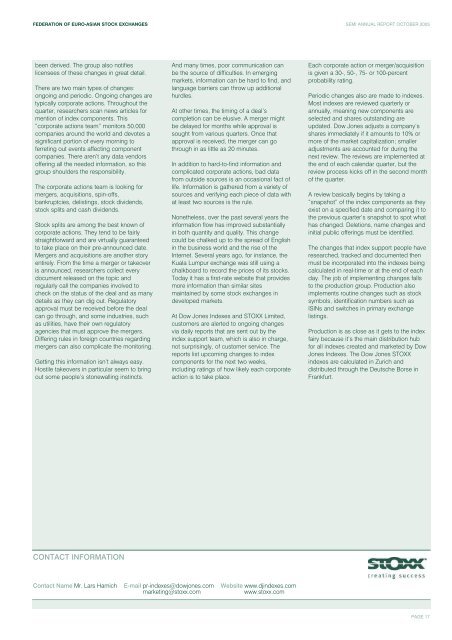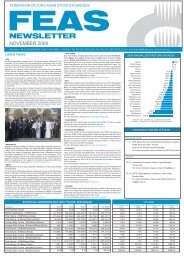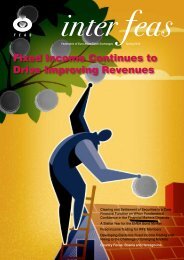Download - FEAS
Download - FEAS
Download - FEAS
You also want an ePaper? Increase the reach of your titles
YUMPU automatically turns print PDFs into web optimized ePapers that Google loves.
FEDERATION OF EURO-ASIAN STOCK EXCHANGES SEMI ANNUAL REPORT OCTOBER 2005<br />
been derived. The group also notifies<br />
licensees of these changes in great detail.<br />
There are two main types of changes:<br />
ongoing and periodic. Ongoing changes are<br />
typically corporate actions. Throughout the<br />
quarter, researchers scan news articles for<br />
mention of index components. This<br />
“corporate actions team” monitors 50,000<br />
companies around the world and devotes a<br />
significant portion of every morning to<br />
ferreting out events affecting component<br />
companies. There aren’t any data vendors<br />
offering all the needed information, so this<br />
group shoulders the responsibility.<br />
The corporate actions team is looking for<br />
mergers, acquisitions, spin-offs,<br />
bankruptcies, delistings, stock dividends,<br />
stock splits and cash dividends.<br />
Stock splits are among the best known of<br />
corporate actions. They tend to be fairly<br />
straightforward and are virtually guaranteed<br />
to take place on their pre-announced date.<br />
Mergers and acquisitions are another story<br />
entirely. From the time a merger or takeover<br />
is announced, researchers collect every<br />
document released on the topic and<br />
regularly call the companies involved to<br />
check on the status of the deal and as many<br />
details as they can dig out. Regulatory<br />
approval must be received before the deal<br />
can go through, and some industries, such<br />
as utilities, have their own regulatory<br />
agencies that must approve the mergers.<br />
Differing rules in foreign countries regarding<br />
mergers can also complicate the monitoring.<br />
Getting this information isn’t always easy.<br />
Hostile takeovers in particular seem to bring<br />
out some people’s stonewalling instincts.<br />
CONTACT INFORMATION<br />
And many times, poor communication can<br />
be the source of difficulties. In emerging<br />
markets, information can be hard to find, and<br />
language barriers can throw up additional<br />
hurdles.<br />
At other times, the timing of a deal’s<br />
completion can be elusive. A merger might<br />
be delayed for months while approval is<br />
sought from various quarters. Once that<br />
approval is received, the merger can go<br />
through in as little as 20 minutes.<br />
In addition to hard-to-find information and<br />
complicated corporate actions, bad data<br />
from outside sources is an occasional fact of<br />
life. Information is gathered from a variety of<br />
sources and verifying each piece of data with<br />
at least two sources is the rule.<br />
Nonetheless, over the past several years the<br />
information flow has improved substantially<br />
in both quantity and quality. This change<br />
could be chalked up to the spread of English<br />
in the business world and the rise of the<br />
Internet. Several years ago, for instance, the<br />
Kuala Lumpur exchange was still using a<br />
chalkboard to record the prices of its stocks.<br />
Today it has a first-rate website that provides<br />
more information than similar sites<br />
maintained by some stock exchanges in<br />
developed markets.<br />
At Dow Jones Indexes and STOXX Limited,<br />
customers are alerted to ongoing changes<br />
via daily reports that are sent out by the<br />
index support team, which is also in charge,<br />
not surprisingly, of customer service. The<br />
reports list upcoming changes to index<br />
components for the next two weeks,<br />
including ratings of how likely each corporate<br />
action is to take place.<br />
Contact Name Mr. Lars Hamich E-mail pr-indexes@dowjones.com Website www.djindexes.com<br />
marketing@stoxx.com www.stoxx.com<br />
Each corporate action or merger/acquisition<br />
is given a 30-, 50-, 75- or 100-percent<br />
probability rating.<br />
Periodic changes also are made to indexes.<br />
Most indexes are reviewed quarterly or<br />
annually, meaning new components are<br />
selected and shares outstanding are<br />
updated. Dow Jones adjusts a company’s<br />
shares immediately if it amounts to 10% or<br />
more of the market capitalization; smaller<br />
adjustments are accounted for during the<br />
next review. The reviews are implemented at<br />
the end of each calendar quarter, but the<br />
review process kicks off in the second month<br />
of the quarter.<br />
A review basically begins by taking a<br />
“snapshot” of the index components as they<br />
exist on a specified date and comparing it to<br />
the previous quarter’s snapshot to spot what<br />
has changed. Deletions, name changes and<br />
initial public offerings must be identified.<br />
The changes that index support people have<br />
researched, tracked and documented then<br />
must be incorporated into the indexes being<br />
calculated in real-time or at the end of each<br />
day. The job of implementing changes falls<br />
to the production group. Production also<br />
implements routine changes such as stock<br />
symbols, identification numbers such as<br />
ISINs and switches in primary exchange<br />
listings.<br />
Production is as close as it gets to the index<br />
fairy because it’s the main distribution hub<br />
for all indexes created and marketed by Dow<br />
Jones Indexes. The Dow Jones STOXX<br />
indexes are calculated in Zurich and<br />
distributed through the Deutsche Borse in<br />
Frankfurt.<br />
PAGE 17
















